The HandScope LED is the only unit that alters and chooses wavelengths like a forensic light source.
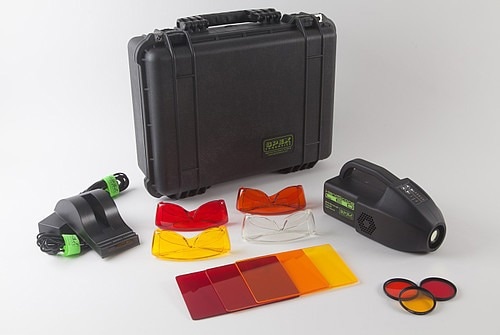
Image Credit: HORIBA Scientific
Features
Use and benefits
LED-based Alternate Light Sources have traditionally had a significant intensity advantage over conventional battery-powered bulb-based light sources. Historically, users could put a lot of LEDs into a compact handheld unit and illuminate evidence over an extended period on a single charge.
However, the LED units had several flaws, including the requirement for numerous units to cover the spectrum, very large diffuse patches (output), and they generated a lot of heat over time, which was uncomfortable for the user.
The HandScope® LED was created to address the shortcomings of conventional LED light sources in unexpected ways.
Most crucially, the unit includes five wavelengths, allowing it to span the entire spectrum that the forensic community has come to expect from a forensic light source.
The HandScope® LED is exceptionally bright. Each wavelength delivers remarkable power when packed with numerous LEDs per color, creating fluorescence for the application associated with that wavelength.
Power
One of the most robust LED units on the market is the HandScope LED. It has a 25,000-hour Light Engine with five wavelengths. Each wavelength consumes 40 W. The HandScope LED has a replaceable, rechargeable lithium-ion battery with a three-hour runtime. When the battery in the HandScope LED runs out, the user can replace it or plug the gadget into AC power. The item will operate normally while charging the battery.
HandScope LED HS-LED
Video Credit: HORIBA Scientific
Versatile and easy to use
The HandScope LED is one of the most user-friendly LED light sources. There is no need to replace components or have numerous lights nearby because all five wavelengths are contained in a single unit. The ability to pick and change wavelengths at the touch of a button lets the user quickly identify and select the optimal wavelength for the evidence in question. The HandScope LED is a single unit with five different wavelengths.
The HandScope LED is backlit for usage in darkened environments, with simple, intuitive controls.
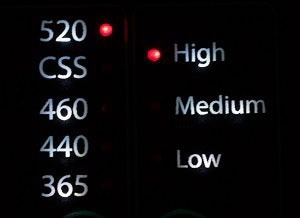
Image Credit: HORIBA Scientific
Where the handscope LED is different from every other LED alternate light Source is in its Focused, Coherent Light Spot
This provides greater control over where the light is placed. It also produces superior results since a focused “hot spot” free illumination casts more light on the evidence.
The more light one can shine on the evidence, the more fluorescence there is, and the better the photography. Many LED alternate light sources advertise high intensity. However, most of that light is wasted when a unit is very bright but has a diffuse, unfocused area. It is not enough for a forensic light source to be bright; it must also be focused.

A focused, coherent spot. Image Credit: HORIBA Scientific
Total control over output and wavelength
The unit offers three power settings: “High”, “Medium”, and “Low”. This enables the user to choose the best mode of operation for the unit, choosing between intensity and runtime. The “High” power level is typically used for preliminary examination to establish the fluoresces and at what wavelength. Even at its most intense, the unit can run continuously for one hour.
Once the documentation begins, the “Low” power setting is used. The unit will run for three hours at this level, providing more than enough power for photography. When conditions allow for less power for research and greater runtime for photography, “Medium” power is used. Simply switch off the machine to shut it down.
The HandScope LED turns on and off instantly. The rechargeable and changeable lithium-ion battery delivers consistent power throughout the cycle. The HandScope LED would not dim as the battery reaches its discharged state.
The lithium-ion battery incorporates an LCD Charge indicator, so users always know how much power is left in the unit and if a backup battery is charged.
The fuel gauge, which is visible via the battery compartment door, provides real-time information on the remaining battery charge.
The HandScope LED generates a directed, coherent light for even illumination to maximize the light on a sample. The illumination’s coherence is maintained at all distances.
Regardless of how long the HandScope LED has been turned on, it always remains cool to the touch. The HandScope LED, unlike many other LED light sources, does not heat up or become hot to the touch. The unit’s effective cooling technology eliminates the need for a cool-down period. “True UV” is included in the HandScope LED.
Many LED systems still employ purple LEDs or wavelengths around 400 nm. The HandScope LED produces the same UV wavelength as its bulb-based counterparts at 365 nm.
Specifications
Technical specifications
- Illuminator Type: High-efficiency light emitting diodes
- Display: For wavelength and intensity, backlit for operation in dark environments
- Lifetime: 25,000 hours
- Operating temperature range: 0 °C to 35 °C
- Weight: <3 lbs./< 1.36 kg, including battery
Main unit
- Total power consumption: 90 W
- Input voltage: 10–24 VDC
Power supply
- Input voltage: 90–264 VAC
- Input frequency: 47–63 Hz
- Total power output: 100 W
Features
- 25,000-hour rated LED engine
- Electronic control of wavelength and intensity selection
- One-hand operation
- 110-220 VAC power supply for the main unit and external charger
- Five wavelengths total: UV(365), 440, 460, CSS (Crime Scene Search), 520
- One lithium-ion battery
- External charger for the battery
- 3–62 mm dia. camera filters (yellow, orange, red)
- Four pairs of goggles (White, Yellow, Orange, Red)
- Manual
- Rugged carrying case
Applications
Detection of body fluids with an alternate light source
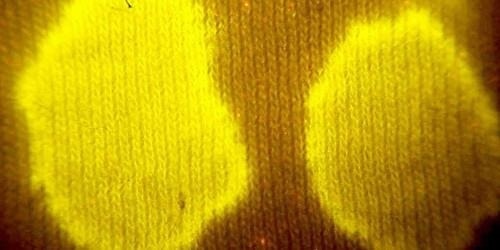
Image Credit: HORIBA Scientific
Even though body fluids like semen, saliva, and vaginal fluids are naturally fluorescent, using a light source provides a different method for locating them. Instead of evaluating complete, huge items of evidence, such as a mattress, carpet, sheet, or article of clothing, a crime scene investigator can narrow down the particular regions of stains for collection. The dried body fluids glow when illuminated by light sources.
Bruises, bite marks, and pattern wounds

Image Credit: HORIBA Scientific
A tunable or multiple wavelength forensic light source can disclose bruising and patterned wound characteristics unseen under conventional white light illumination on some individuals.
Detection of gun shot and explosive residues
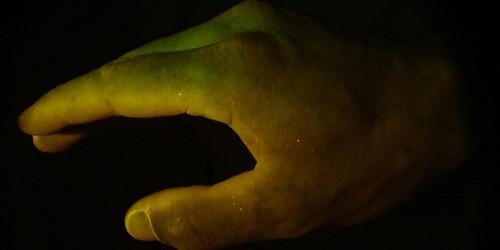
Image Credit: HORIBA Scientific
Many different types of residues are found in ammunition and explosives, which fluoresce. Observations of items can be made without touching the surface using a tunable forensic light source to detect if fluorescent residues are present.
Detection of trace evidence

Image Credit: HORIBA Scientific
Forensic and other light sources can identify both fluorescent and non-fluorescent trace evidence.
Questioned documents
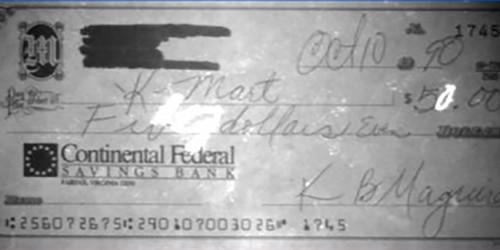
Image Credit: HORIBA Scientific
The primary applications concerning questioned documents and alternative light sources pertain to “ink differentiation”. Many inks have various formulas even within the same apparent color type. By observing ink responses as the hue of the light is tuned across the visible and infrared areas, a tunable forensic light source can be utilized to determine tiny differences in ink type.